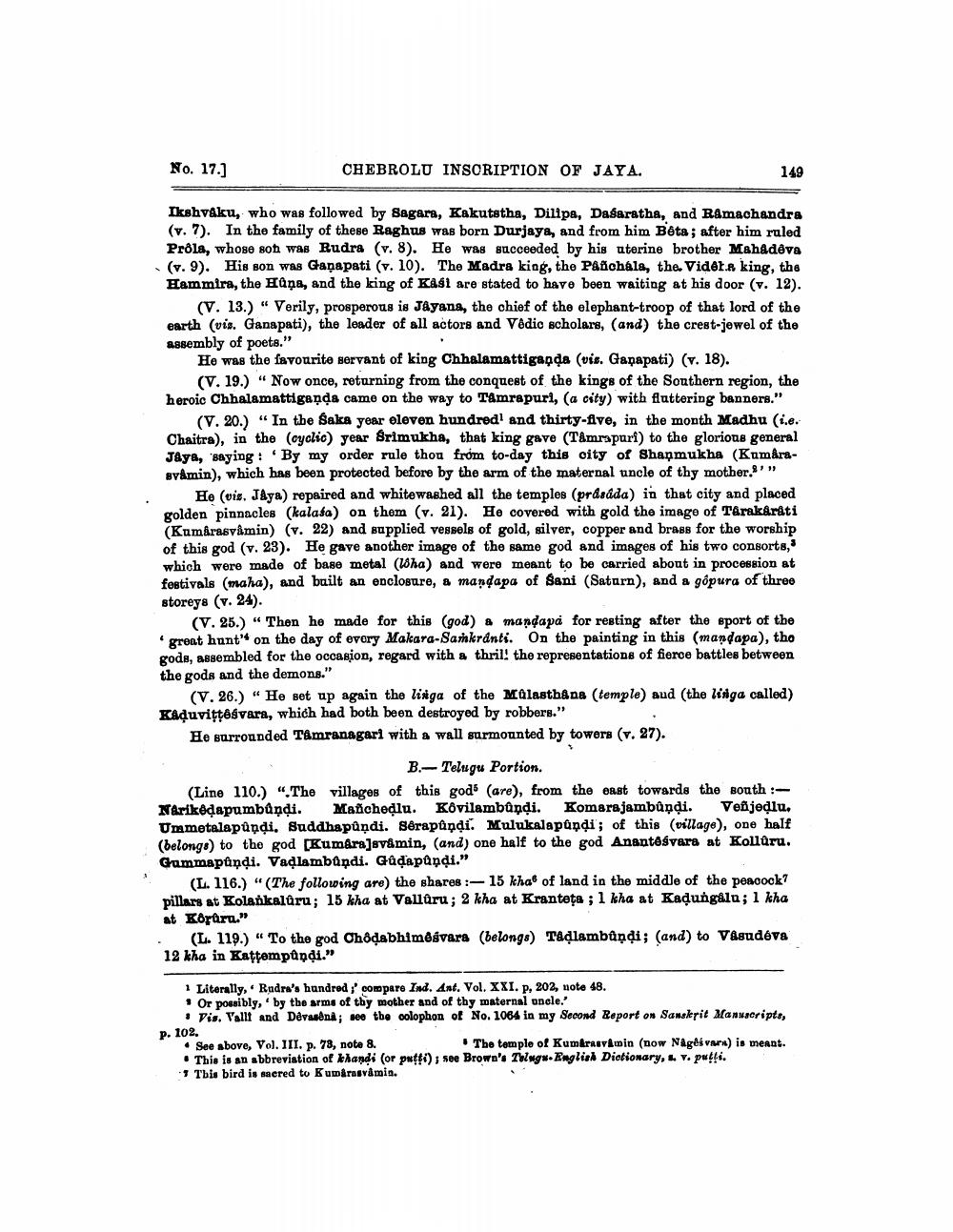________________
No. 17.]
CHEBROLU INSCRIPTION OF JAYA.
149
Ikshváku, who was followed by Sagara, Kakutstha, Dilipa, Dagaratha, and Ramachandra (v.7). In the family of these Raghus was born Durjaya, and from him Beta; after him ruled Prðla, whose son was Rudra (v. 8). He was succeeded by his uterine brother Mahadeva (v. 9). His son was Ganapati (v. 10). The Madra king, the Patchála, the. Videta king, the Hammira, the HQņa, and the king of Kasi are stated to have been waiting at his door (v. 12).
(V. 13.) “Verily, prosperous is JAyana, the chief of the elephant-troop of that lord of the earth (vis. Ganapati), the leader of all actors and Vedic scholars, (and) the crest-jewel of the assembly of poets."
He was the favourite servant of king Chhalamattiga da (vis. Gapapati) (v. 18).
(V. 19.) “ Now once, returning from the conquest of the kings of the Southern region, the heroic Chhalamattiga da came on the way to Tamrapuri, (a city) with fluttering banners."
(V. 20.) “In the Saka year eleven hundred and thirty-five, in the month Madhu (i.e. Chaitra), in the (cyclic) year Srimukha, that king gave (Tamrspuri) to the glorious general Jaya, "saying: By my order rule thou from to-day this city of Shanmukha (Kumarasvåmin), which has been protected before by the arm of the maternal uncle of thy mother.'"
He (vie. Jaya) repaired and whitewashed all the temples (pråsåda) in that city and placed golden pinnacles (kalasa) on them (v. 21). He covered with gold the image of Terakáráti (Kumarasyimin) (v. 22) and supplied vessels of gold, silver, copper and brass for the worship of this god (v. 23). He gave another image of the same god and images of his two consorts, which were made of base metal (Wha) and were meant to be carried about in procession at festivals (maha), and built an enclosure, & mandapa of Sani (Satarn), and a gopura of three storeys (v. 24).
(V. 25.) “ Then he made for this (god) a mandap, for resting after the sport of the great hunt' on the day of every Makara-Sankrants. On the painting in this (mandapa), tho gods, assembled for the occasion, regard with a thrill the representations of fierce battles between the gods and the demons."
(V. 26.) " He set up again the liviga of the Malasthana (temple) aud (the linga called) Kaduvittesvara, which had both been destroyed by robbers." He surrounded Tämranagari with a wall surmounted by towers (V. 27).
B.- Telugu Portion. (Line 110.) “.The villages of this gods (are), from the east towards the south :Nerikedapumbúņdi. Mañchedlu. Kovilambundi. Komarajambûndi. Vefjediu. Ummetalapundi. Suddhapundi. Sérapiņdi. Mulukalapundi; of this (village), one half (belongo) to the god [Kumara]svimin, (and) one half to the god Ananteśvara at Kollûru. Gammaplindi. Vadlambandi. Güďapandi."
(L. 116.) “ (The following are the shares :- 15 kha of land in the middle of the peacock? pillars at Kolankalûru; 15 kha at Vallûru; 2 kha at Kranteta ; 1 kha at Kadungalu; 1 kha at Korru."
(L. 119.) “ To the god Chodabhim svara (belongs) Tadlambůņại; (and) to Vasudeva 12 kha in Kattem pundi."
1 Literally,. Rudra's hundred compare Ind. Ant. Vol. XXI. p, 202, uote 48. • Or possibly, by the arms of thy mother and of thy maternal uncle.'
• Vis. Vallt and Devasena; see the colophon of No. 1064 in my Second Report on Sanskrit Manuscripts, P. 102. • See above, Vol. III. p. 78, note 8.
The temple of Kumkrasimin (now Någésvars) is meant. • This is an abbreviation of khandi (or putt), see Brown's Twngs. English Dictionary, .. . pulfi. ** Tbis bird is sacred to Kumkrasvamin.




